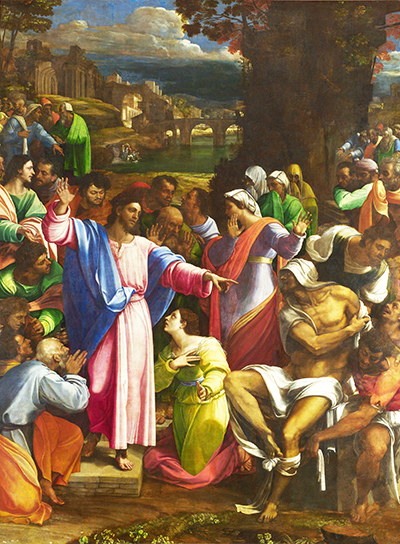Sebastiano del Piombo's The Raising of Lazarus is amongst his most famous and technically impressive painting
It was completed around 1517-1519 in collaboration with Michelangelo, with the two artists sharing a strong working relationship for several decades. Michelangelo provided several figurative drawings for this project and Sebastiano then completed the painting himself.
Cardinal Giulio de' Medici would commission this piece and the two artists were at this stage competing with Raphael over becoming the spearhead of the High Renaissance. They were from different regions of the Italian papal states and their conflict helped to spur their achievements on even further. Whilst Raising of Lazarus remains in the National Gallery in London, UK where it has been for many years, this painting was previously at the centre of a power struggle right at the heart of the Italian Renaissance.
The Narbonne Cathedral in France was the expected destination for this artwork along with Raphael's Transfiguration. The donor later announced that he believed that Raphael's was the finest of the two but art critics generally agree that both paintings are of supreme quality and worthy of their respective creators. Sebastiano himself was not a confrontational person and was drawn into this conflict by a proud and outspoken Michelangelo.
Whilst receiving the finest care since arriving at the National Gallery in around 1824, this painting has received signs of wear and tear over the centuries since it was completed and some of the brightness of the original colouring has been lost. Sebastiano would want to have displayed the Venetian style of brightness to his Roman audience within this painting but it is more apparent in some of his other remaining works. Titian's career also followed this style, particularly in famous paintings such as Venus of Urbino, Assumption of the Virgin and Pieta. Michelangelo, as a Florentine, would not have cared about that and was more focused on the initial figurative poses that his colleague would later implement.
There were many competitions within the era of the Renaissance, though normally they were put on to find the most suitable artist to carry out a particular project. In this case, it was purely a battle of egos between Michelangelo and Raphael, with Sebastiano caught somewhat in the middle. Few will forget the council commissions that set the likes of Filippo Brunelleschi, Donatello and Lorenzo Ghiberti up against each other on several occasions.
Sebastiano had been living in Rome for around five years by the time of this painting and it is clearly evident within the style that he uses for it. Whilst the bright tones of his Venetian background are still present, there is an impression of Roman classicism to be found here, reminding us, ironically, of Raphael. Whilst competing against that particular master, Sebastiano had unconciously imparted some of his influence into this piece.
The items of architecture within this painting are particularly of a Roman style whilst the lighter landscape scenery and sky point to his earlier education in Venice. Different studios, even cities, within the Renaissance would develop very much their own characteristics which would ensure that an artist's background was very relevant to the eventual style that he incorporated into his work.




